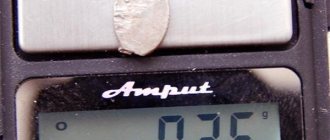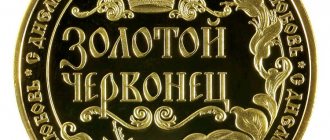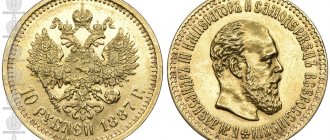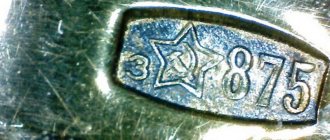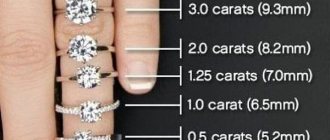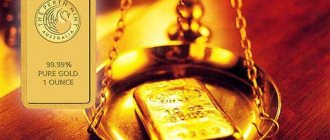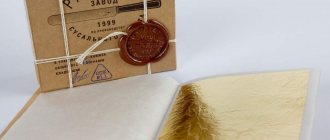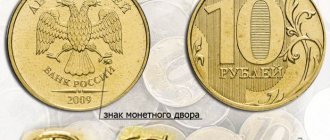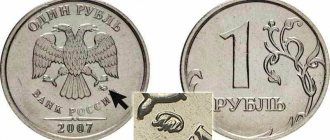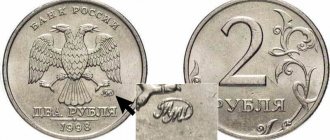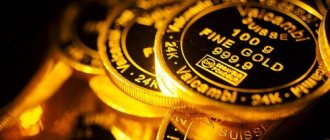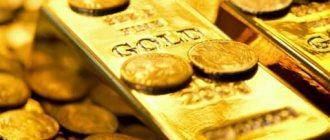In connection with the news about the appearance of another rare coin with a face value of 5 rubles, I decided to write this entry; I had not done this before due to the fact that the news could turn out to be a hoax and I did not want to mislead you. Fortunately or unfortunately (due to the fact that this coin most likely will not appear in my collection), the news was confirmed, there are people who held this rarity in their hands, so meet the new very rare 5 ruble coin of 2011, minted by St. Petersburg mint.
Story
Despite the fact that the date “1997” is on the reverse of the coin, the issue of these banknotes took place in 1998, during the monetary reform. To make five rubles of 1997, copper blanks clad with two layers of cupronickel were used.
The circulation was very large; two organizations were engaged in minting at once. This led to the appearance of a large number of varieties - two issued by Moscow and another five to seven (different data are indicated in different catalogs) produced by the St. Petersburg Mint.
5rubleka has a number of interesting features. Firstly, one of the stamp options - 1.1 according to A. Stashkin - is the same for both mints. It looks as if initially both organizations should have issued banknotes that were as similar as possible. Secondly, the five-ruble coin of 1997 is the largest and heaviest of all circulating metal money issued by the Bank of Russia. Subsequently, only a few anniversary ones exceeded its diameter.
The edge, consisting of twelve corrugated sections separated by smooth intervals, acts as protection against counterfeiting. There are 60 corrugations in total, i.e. 5 at each site. On most banknotes, a narrow pink strip of copper, not covered with nickel silver, is visible on the edge.
Characteristics
Banknotes have the following characteristics:
- weight – 2.45 g;
- thickness – 1.8 mm;
- diameter – 25.0 mm;
- metal – copper coated with cupronickel;
- the edge is corrugated, the corrugations alternate with smooth intervals.
The coin is non-magnetic. There is raised trim on both sides.
Obverse
The front side of the banknote depicts a double-headed eagle with lowered wings. Under his right paw is the mint mark: “MMD” (Moscow) or “SPMD” (St. Petersburg).
At the top, above the bird’s head, along the edge is the text: “BANK OF RUSSIA.” Below, under the eagle, there is an inscription: “FIVE RUBLES.” Below it is a horizontal line, pointed at the edges and divided by a large dot. Even lower, along the edge, is the release date – “1997”.
Reverse
The reverse side shows the number “5”, indicating the denomination of the banknote. Relative to the center, it is shifted to the left and up. Below it is the word “RUBLE”. To the right of the coin is a stylized floral design. Fragments of it can be seen below and to the left along the edge.
Catalog of anniversary 5-ruble coins:
- Series “Battles and significant events of the Patriotic War of 1812” (10 pieces)
- Series “70th anniversary of Victory in the Great Patriotic War of 1941-1945.” (18 pcs.)
- Series “The feat of Soviet soldiers who fought on the Crimean Peninsula during the Great Patriotic War of 1941-1945.” (5 pieces.)
- Coin “170th anniversary of the Russian Geographical Society”
- Series “Cities - capitals of states, liberated by Soviet troops from the Nazi invaders” (14 pcs.)
- Coin “150th anniversary of the founding of the Russian Historical Society”
For 2021 - 2021 The Bank of Russia has not planned to issue anniversary and commemorative fives.
Anniversary fives are minted from steel blanks coated with nickel. Their diameter is 25 mm, thickness is 1.8 mm. Their general design is similar to the circulating metal money of the 1997 model.
On the obverse, the denomination is indicated in the center - “5 RUBLES”, under which there is the inscription: “BANK OF RUSSIA” and the year of minting, on the sides there are branches of plants, the mint mark is located on the right side of the edge. The reverse of each issue is unique. It contains an image and inscriptions corresponding to the event to which the metal product is dedicated.
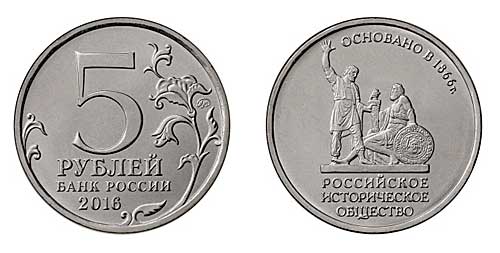
At the end of the catalog there is information on the cost of anniversary fives.
2012 series “Battles and significant events of the Patriotic War of 1812...”
The full title of the series is “Battles and significant events of the Patriotic War of 1812 and foreign campaigns of the Russian army of 1813-1814.” It was issued as part of the 2012 celebrations of the 200th anniversary of Russia's victory in the Patriotic War of 1812 and includes 10 coins.
On the reverse of each copy there is a monument, along the circumference of the inscription: in the lower part “Patriotic War of 1812”, in the upper part - the name of the event or battle in memory of which the five was made.
All 5 rubles from this series were minted at the Moscow Mint. Each coin was issued in a quantity of at least 5 million copies.
List of anniversary fives of 2012:
| Photo | Name | Mint | Circulation |
| Battle of Krasnoye | MMD | 5 million | |
| Battle of Smolensk | MMD | 5 million | |
| battle of Borodino | MMD | 5 million | |
| Battle of Vyazma | MMD | 5 million | |
| Battle of Maloyaroslavets | MMD | 5 million | |
| Battle of Tarutino | MMD | 5 million | |
| Battle of Berezina | MMD | 5 million | |
| Battle of Kulm | MMD | 5 million | |
| Battle of Leipzig | MMD | 5 million | |
| Capture of Paris | MMD | 5 million |
2014 series “70th anniversary of Victory in the Great Patriotic War of 1941-1945.”
A year before our country celebrates the 70th anniversary of Victory in the Great Patriotic War of 1941-1945. A series of 5-ruble commemorative coins was prepared, dedicated to the largest military operations of this war. As part of the series, 18 fives were released in 2014.
Issues of the series are distinguished by the reverse, on which the corresponding monument is depicted in the center; also on the reverse along the edge there are inscriptions - “The Great Patriotic War of 1941-1945.” and the name of the battle or military operation. The inscriptions are separated by stars.
All copies of the series were minted by the Moscow Mint, the circulation of each issue was 2 million pieces.
List of anniversary 5 rubles 2014:
| Photo | Name | Mint | Circulation |
| Battle of Moscow | MMD | 2 million | |
| Battle of Stalingrad | MMD | 2 million | |
| Battle for the Caucasus | MMD | 2 million | |
| Battle of Kursk | MMD | 2 million | |
| Battle of the Dnieper | MMD | 2 million | |
| Dnieper-Carpathian operation | MMD | 2 million | |
| Battle for Leningrad | MMD | 2 million | |
| Belarusian operation | MMD | 2 million | |
| Lviv-Sandomierz operation | MMD | 2 million | |
| Iasi-Kishinev operation | MMD | 2 million | |
| Baltic operation | MMD | 2 million | |
| Operation to liberate Karelia and the Arctic | MMD | 2 million | |
| Budapest operation | MMD | 2 million | |
| Vistula-Oder operation | MMD | 2 million | |
| East Prussian operation | MMD | 2 million | |
| Vienna operation | MMD | 2 million | |
| Berlin operation | MMD | 2 million | |
| Prague operation | MMD | 2 million |
2015 series “The feat of Soviet soldiers who fought on the Crimean Peninsula during the Great Patriotic War of 1941-1945.”
In the year of Russia's celebration of the 70th anniversary of the victory in the Great Patriotic War of 1941-1945. A mini-series of commemorative coins worth five rubles was born, dedicated to the feat of Soviet soldiers who fought on the Crimean Peninsula. A total of 5 issues were carried out. The circulation of each issue is 2 million copies, all of them have the mark of the Moscow Mint.
The reverse of the 5s of the 2015 series is decorated with an image of the corresponding monument; along the edge you can read the inscriptions: “The Great Patriotic War of 1941-1945,” as well as the name of the event.
List of anniversary fives of 2015:
| Photo | Name | Mint | Circulation |
| Defense of Sevastopol | MMD | 2 million | |
| Defense of the Adzhimushkay quarries | MMD | 2 million | |
| Kerch-Eltigen landing operation | MMD | 2 million | |
| Crimean strategic offensive operation | MMD | 2 million | |
| Partisans and underground fighters of Crimea | MMD | 2 million |
5 rubles 2015: “170th anniversary of the Russian Geographical Society”
In 1866, the Russian Geographical Society (RGS) was created, the purpose of which is to collect and disseminate reliable geographical information. Over the years of the existence of the Russian Geographical Society, during numerous expeditions not only the territory of our country was explored, but new lands were discovered and studied. In 2015, the 170th anniversary of the Russian Geographical Society was celebrated on commemorative coins in denominations of 5 rubles. As part of the issue dedicated to the anniversary of the Russian Geographical Society, the Moscow Mint minted 5 million coins.
| Photo | Name | Mint | Circulation |
| 170th anniversary of the Russian Geographical Society | MMD | 5 million |
2021 series “Cities - capitals of states liberated by Soviet troops from the Nazi invaders”
Continuing the theme of Russia's victory in the Great Patriotic War of 1941-1945. In 2021, another series of 5-ruble anniversary coins was issued. This time the series was dedicated to the capital cities of states liberated by Soviet troops from the Nazi invaders. The series consists of 14 issues. On the reverse of the coin of each issue you can see the image of the monument erected in the capital liberated by Soviet troops, the name of the city, as well as the date of its liberation.
All coins in the series were minted by the Moscow Mint, as evidenced by the MMD mark, which can be found on the obverse. The circulation of each issue is 2 million.
List of top fives 2021:
| Photo | Name | Mint | Circulation |
| Kyiv. November 6, 1943 | MMD | 2 million | |
| Minsk. July 3, 1944 | MMD | 2 million | |
| Vilnius. 07/13/1944 | MMD | 2 million | |
| Kishinev. 08/24/1944 | MMD | 2 million | |
| Bucharest. 08/31/1944 | MMD | 2 million | |
| Tallinn. 09/22/1944 | MMD | 2 million | |
| Riga. 10/15/1944 | MMD | 2 million | |
| Belgrade. 10/20/1944 | MMD | 2 million | |
| Warsaw. 01/17/1945 | MMD | 2 million | |
| Bratislava. April 4, 1945 | MMD | 2 million | |
| Budapest. 02/13/1945 | MMD | 2 million | |
| Vein. 04/13/1945 | MMD | 2 million | |
| Berlin. May 2, 1945 | MMD | 2 million | |
| Prague. 05/09/1945 | MMD | 2 million |
“150th anniversary of the founding of the Russian Historical Society”, 2016
In 1866, the Russian Historical Society was created with the aim of collecting, distributing and introducing into scientific circulation documents and materials on history. In 2021, the Russian Historical Society turns 150 years old. This fact is reflected on the commemorative coins of 5 rubles.
| Photo | Name | Mint | Circulation |
| 150th anniversary of the founding of the Russian Historical Society | MMD | 5 million |
Varieties
Experts do not have a common opinion about the total number of varieties of five-ruble coins. For 5 rubles of 1997 MMD, they unanimously include 2 types, but there are disagreements regarding banknotes issued by SPMD. Various catalogs indicate that in St. Petersburg fives of 1997 were stamped with five or seven reverse stamps.
The copies of MMD and SPMD differ from each other only in the details of the reverse side. The obverse is made the same way both in Moscow and St. Petersburg.

You can distinguish coins in a photo or in person, first of all, by the left and right corners of the denomination number. Additional differences are the beveled or straight steps of the letters in the inscription “RUBLES”, the size of the edging, the distance at which the sheet is from the edging and the size of the dot.
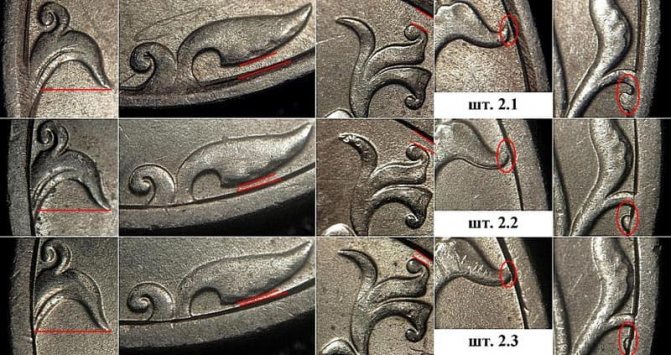
The table below shows all the varieties of five-ruble notes from 1997 according to Yuri Kulvelis’s catalogue.
| Designation (according to J. Kulvelis) | Peculiarities | Reverse stamp |
| SPMD | ||
| 1.1 | The number “five” has a sharp left corner; in the inscription “rubles” the steps of the letters are rectangular. | 1.1 |
| 1.2 | The left corner of the denomination number is pointed; in the inscription the steps of the letters are beveled | 1.2 |
| 2.1 | The left corner of the number “five” is rounded, the leaf does not touch the edge, the dot is large, the edging is wide | 2.1 |
| 2.2 | Rounded left corner of the number "5", the leaf is in contact with the edge, medium-sized dot, enlarged image | 2.2 |
| 2.3 | The left corner of the number “5” is rounded, the leaf is in contact with the border, the dot is small. | 2.3 |
| MMD | ||
| 1.1 | The corner on the right side of the five is not rounded | 1.1 |
| 1.3 | The five on the right has a rounded corner | 1.3 |
Numbers 1 and 6 have a common designation - 1.1. The rarest variety - 5 rubles 1997 SPMD number 2.3 are found only in sets; such coins come into circulation only by accident.
The most expensive 5 ruble coins of the USSR and early Russia
The five-ruble denomination is not typical for coins of the Soviet Union. Having put monetary circulation in order and launched a line of coins ending with the ruble, the Soviet government, even during the difficult war period, managed to prevent hyperinflation and stay within the given line almost until the collapse of the country into separate republics.
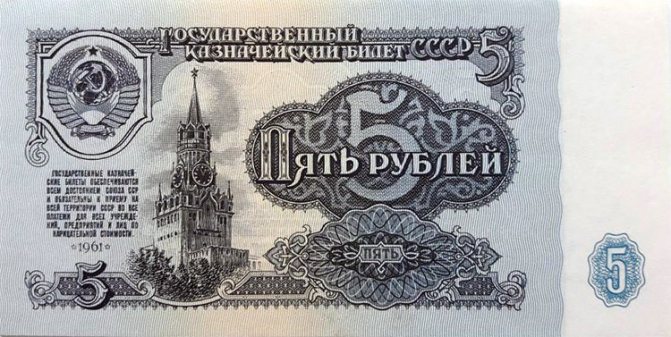
Paper 5 rubles 1961
During the period of the late USSR, the five-ruble denomination was represented by the State Treasury note. The blue banknote featured the Spasskaya Tower of the Moscow Kremlin, which by that time had become practically a state symbol. Until 1991, the denomination and name of the currency, in addition to the Russian spelling, was duplicated in the languages of all Soviet republics. However, metal fives could have appeared in the piggy banks and wallets of Soviet citizens back in the late 50s.
5 rubles 1958
Having visited the United States of America, Nikita Sergeevich Khrushchev admired the work of vending machines. According to the Soviet leader, a working person should create a product, and not sell it from behind the counter. Widespread automation of sales could send a large army of salespeople to the forefront of production. Self-service departments began to appear in stores, where several salespeople were replaced by a single cashier. Now it was supposed to automate the repayment process itself. All kinds of research institutes began developing vending machines. Some of them settled for decades in busy areas of the cities of the Soviet Union. The machines sold newspapers and dispensed soda. But “heavy artillery” was also required, which would ensure the sale of goods, the price of which was not in pennies, but in rubles.
1956 proof coin (left) and 1958 mass mintage example (right)
The largest denomination of the new coin series was planned to be five rubles. In various metals, test 5 rubles of 1956 are known, whose weight varied from 4.35 to 21.90 grams. For the mass edition of 1958, they decided on the metal (it became nickel silver - an alloy of copper and nickel with impurities). The diameter of the coin is 34 mm, weight is 16.9 grams. However, the coins did not enter circulation and were subsequently destroyed. During the reform of 1961, they decided not to mint denominations older than the ruble. However, fives of approximately the same size and weight appeared in circulation three decades later: we are talking about commemorative coins of 1988-1991. Unlike other ruble denominations, the 5 ruble 1958 appears at auctions more often due to the large number of coins in very poor condition. Who says that they were lifted in a bag from the Kronverk Strait. Others claim that these are the remains of the reserves of the burnt savings bank of Murmansk or Arkhangelsk, where the coins were delivered before the reform and did not have time to be withdrawn due to the fire.
What should you pay attention to?
5 rubles from 1958 is not a coin that is sold in any numismatic store or collectors club. However, the market is filled with numerous copies. However, for now, a careful eye can easily distinguish a copy from the original. But you need to be careful with coins whose field is corroded or melted. Attempts have been recorded to slip in a mutilated copy under the guise of a damaged original.
5 rubles 1987

5 rubles 1987 (regular coinage)
The five-ruble denomination returns to the 70th anniversary of the October Revolution as part of a series of three commemorative coins. Of all the metal fives, this is the largest (29 grams) and heaviest (39 millimeters), which is why it received the nickname “Puck” in collecting circles. Apparently, complaints about the inconvenience of such a large and weighty coin for everyday payments quickly reached the very top, so the diameter and weight of subsequent copper-nickel five-ruble coins were significantly reduced. In comparison with other commemorative coins, 5 rubles of 1987 “70 years of the Great October Socialist Revolution” were minted not so many (1,300,000 pieces in regular quality and 200,000 in “Proof” quality), which affects the price. There are noticeably fewer “Proof” collectors compared to the bulk of collectors, so the price of “Proof” is not so different from an ordinary coin of excellent preservation.
What should you pay attention to?
Not so long ago, Chinese copies began to be imported en masse. Although experts immediately point out Ilyich’s “Chinese” squint, a novice numismatist may mistake this item for an original. Therefore, you should not immediately grab a coin when you see a price below the market.
5 rubles 1989 “Registan” (smooth edge)
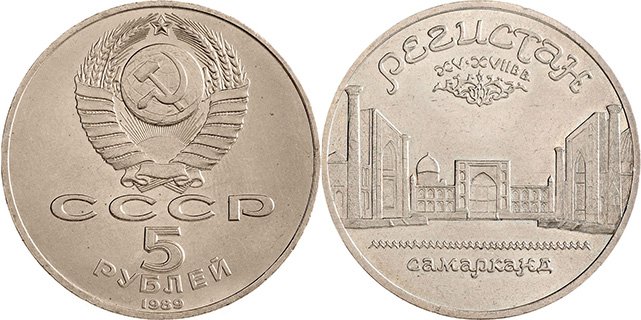
5 rubles 1989 (regular coinage)
The beautiful-sounding word “Registan” means “a place covered with sand,” but this is the name of the main square of Samarkand, which tourists from all over the world come to admire. It is formed by the walls of three ancient educational institutions: the Ulugbek Madrasah (built by the grandson of Tamerlane, a wise ruler and scholar-researcher), the Sherdor Madrasah (translated as “Abode of Lions”) and the Tillya-Kari Madrasah (“Gilded Madrasah”). The coin was issued as part of an extensive program, according to the results of which significant architectural structures and monuments of all 15 republics were to appear on the metal money of the USSR. Of the two million edition, 1,700,000 pieces were made in normal quality. Among them, several specimens were found without the standard edge design (two pressed inscriptions “FIVE RUBLES”, between them two pressed five-pointed stars). They are considered the rarest and most expensive of all the anniversary five-ruble notes of the Soviet Union.
What should you pay attention to?
On the edge. Some craftsmen have gotten the hang of grinding off the inscription in order to pass off an ordinary five as a rarity. But with high magnification, the scratches will still be visible. In addition, the coin will decrease in both diameter and weight.
5 rubles 1991 LMD “Russian Ballet”
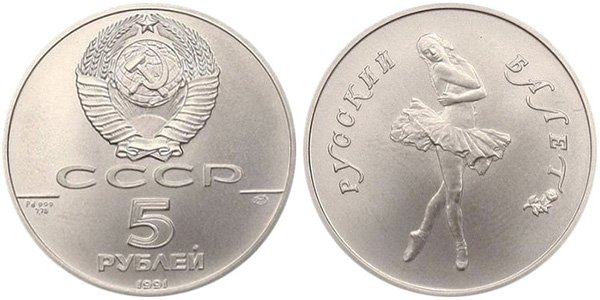
5 rubles 1991 (palladium)
Palladium ranks among the precious metals from which domestic collectible coins are minted, along with gold, silver and platinum in 1988. A coin weighing one troy ounce has a face value of 25 rubles. However, in 1991, they decided to expand the line of palladium coins. This is how the palladium five appeared in the “Russian Ballet” series. It contains 7.78 grams (quarter ounce) of palladium. The diameter is 25 millimeters. The circulation for coins made of precious metals of that period is insignificant - only 9,000 copies. The high price of this coin is ensured by the cost of palladium, which at the beginning of 2020 surpassed even gold in value.
What should you pay attention to?
Only that such coins are bought only in places where the precious metal can be checked for authenticity. In any case, a copy made of base metal will give away weight or discrepancy in dimensions (thickness or diameter).
5 rubles 1991 MMD and LMD
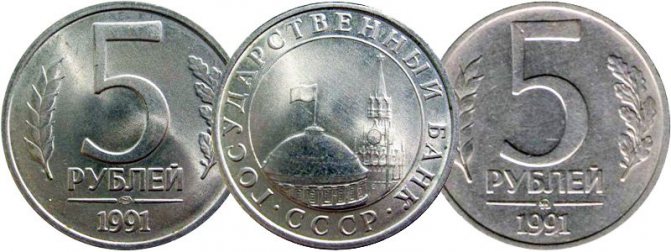
5 rubles 1991 LMD (left) and MMD (right)
But the everyday fives from 1991 are not rare or expensive. They were minted in huge quantities. But it is worth remembering that a coin with a rounded MMD logo is much less common than one with an elongated LMD sign. Therefore, it is worth learning to distinguish the signs.
5 rubles 1991 LMD is not in its metal
However, the LMD fives also have copies that can shock you with their prices. But these are “mix-ups” in metal. Instead of copper-nickel, the coin was minted in a yellow-golden alloy.
What should you pay attention to?
By weight. You need to remember the weight of an ordinary coin. The weight of the “interchange” will not coincide with it. If there is a match, you are almost certainly looking at a colored coin.
5 rubles 1992 MMD
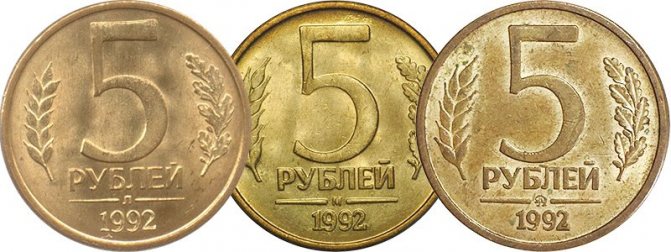
5 rubles 1992 L (left), M (center) and MMD (right)
The everyday fives issued by the Bank of Russia on clad steel are decorated in the same style. And here, due to its rarity, the rounded MMD sign stands out (the other coins have the letter “M” or “L” in the same place). This coin can only be called expensive in comparison with “letter” fives, which are still valued by weight.
5 rubles 1992 L not in his metal
However, here too, “interchanges” in metal are incredibly valuable. The fact that the blank was intended for some other coin is almost always indicated by minting defects, as in the example shown above.
Regular coins and a coin on someone else's blank
“Mix-ups” in the workpiece are also valuable. Five-ruble notes minted on a ruble mug are known. Such unusual coins are welcome guests in collectors' albums.
What should you pay attention to?
In the latter case, you need to be careful not to purchase a trivially sawed-off coin. Well, for coins of an unusual color, in this case, a deviation from the standard weight and diameter of an ordinary five-ruble coin must be observed.
Price
The price depends on which organization produced a particular copy and on the variety. In general, the value of coins issued by MMD rarely exceeds their face value, unless the five is in perfect condition.
Banknotes issued by SPMD cost, on average, 15-100 rubles per piece, depending on the type. Among the rarest, most valuable and expensive coins in Russia we can only include coins minted with stamp 2.3. There is a known case when such a copy was sold at auction for 2,400 rubles.
| Stamp | Mint | Price, in rubles |
| 1.1 | SPMD | 60 |
| 1.2 | 40 | |
| 2.1 | 15 | |
| 2.2 | 20 | |
| 2.3 | 2400 | |
| 1.1 | MMD | 30 |
| 1.3 | 25 |
The table shows the incomplete value of the 1997 5 ruble coin. You need to understand that it can be higher or lower depending on the degree of preservation of a particular specimen.
How to evaluate a coin?
In order to profitably sell a theoretically valuable coin found, the first step is to estimate its market value. Of course, the most accurate and reliable way is to seek advice from experts. But first you can use your own strength.
First of all, you should determine the authenticity of the coin. For this, an ordinary magnifying glass and a catalog with the original banknote are enough. When determining authenticity, a simple rule applies: real coins, as a rule, are distinguished by clear lines and designs (fraudsters often do not “draw” the details so pedantically).
If you have a microscope at home, you can see more valuable information. For example, peeling on the outside of the product is a feature inherent in the originals (it is impossible to fake such a feature). Coins that have not been circulated for a long time may retain their original shine (this can also be easily seen under a microscope).
Taking into account the discovered features, all that remains is to compare the information received with what is indicated in the catalogs of auctions, numismatic clubs, etc. What do specialized organizations take into account when evaluating a coin? Most often, the condition of the coin, its rarity, denomination, period of issue, etc. are taken into account. The last stage is contacting experts to obtain a final opinion and search for potential buyers.
Marriage
If the 5-ruble coins themselves are of practically no interest to collectors, then all sorts of defects that periodically appeared during the minting of banknotes are popular with them.
- Most often there are banknotes with such a defect as a split. Usually the cost of such copies does not exceed 300 rubles, but sometimes it rises higher. There is a known case when a coin with a split was purchased at an auction for 1000 rubles.

- Rotating the reverse by 180° relative to the obverse is less common and therefore costs up to 600 rubles. Partial rotation - 90° - less expensive.
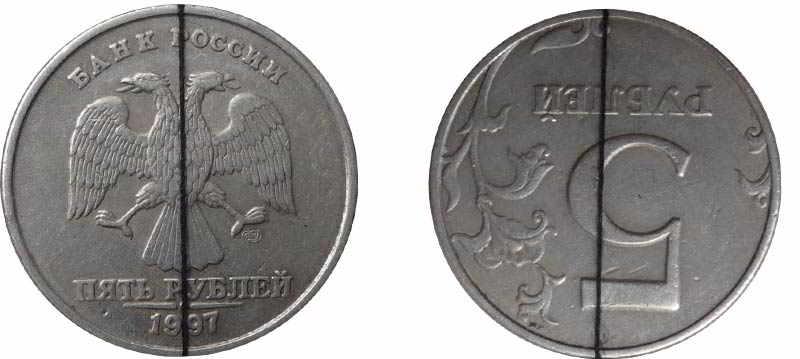
- There is a known case of a coin minted on a blank of non-standard thickness being sold at an online auction. This specimen weighed almost 1 gram more than normal - 7.40 g. It was purchased for 500 rubles.
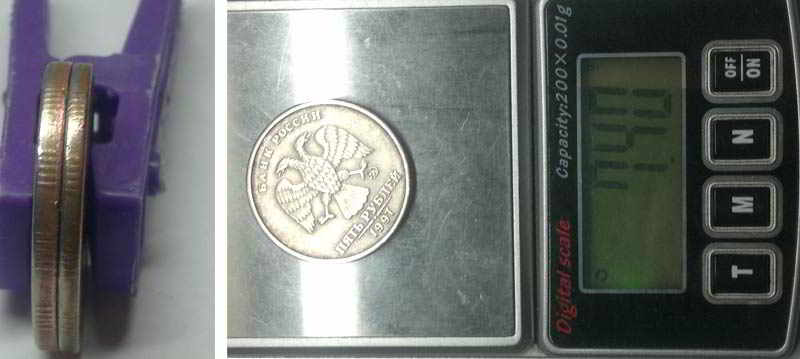
- A popular type of defect for five-ruble banknotes is a split image. The price of such coins is usually low and exceeds the face value by 3-5 times.
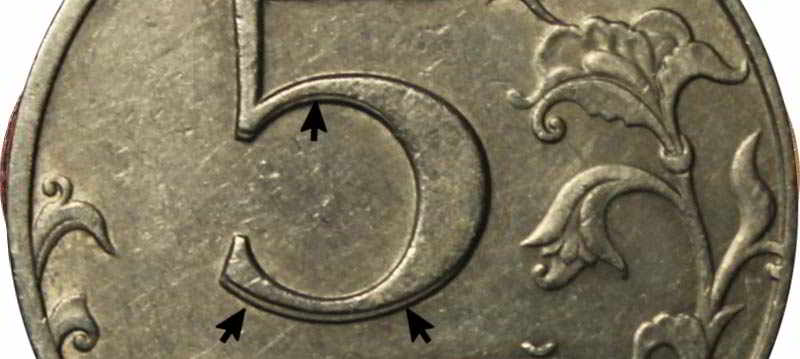
- It is very rare to encounter such a defect as displacement of the image as a result of the workpiece shifting during minting. The cost of such five-ruble bills is from 300 rubles and above.
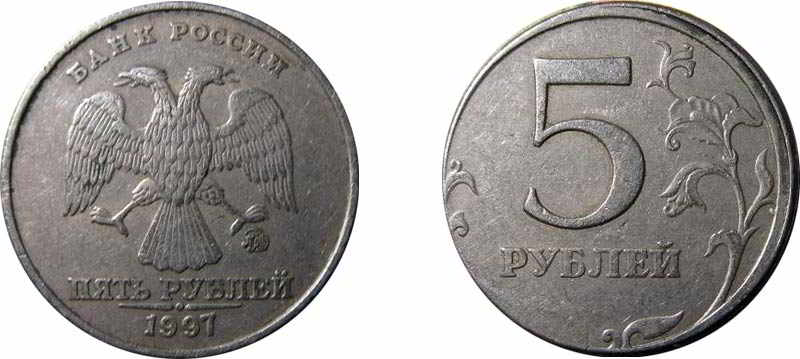
- Coins with clogs and chips are valued less. You can sell them at auctions for 100-200 rubles.

Banknotes of this denomination are not of particular interest to numismatists. Their cost ranges from 15 to 100 rubles, depending on the degree of preservation. The exception was the variety minted by the St. Petersburg Mint with reverse die 2.3. It is very rare, so at auctions its price can rise to several thousand rubles.
